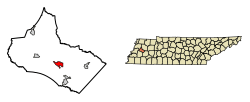Alamo, Tennessee
Alamo is a town in Crockett County, Tennessee. Its population was 2,461 at the time of the 2010 U.S. Census. Alamo, for historical reasons, is the county seat of Crockett County (see Davy Crockett and the Alamo). Alamo is located in the central part of West Tennessee, about 30 miles from the Mississippi River.
Alamo, Tennessee | |
|---|---|
 Buildings along the courthouse square | |
 Location of Alamo in Crockett County, Tennessee. | |
| Coordinates: 35°47′3″N 89°6′57″W | |
| Country | United States |
| State | Tennessee |
| County | Crockett |
| Incorporated | 1911[1] |
| Named for | Battle of the Alamo |
| Area | |
| • Total | 2.20 sq mi (5.69 km2) |
| • Land | 2.20 sq mi (5.69 km2) |
| • Water | 0.00 sq mi (0.00 km2) |
| Elevation | 361 ft (110 m) |
| Population (2010) | |
| • Total | 2,461 |
| • Estimate (2018)[3] | 2,302 |
| • Density | 1,048.27/sq mi (404.76/km2) |
| Time zone | UTC-6 (Central (CST)) |
| • Summer (DST) | UTC-5 (CDT) |
| ZIP code | 38001 |
| Area code(s) | 731 |
| FIPS code | 47-00440[4] |
| GNIS feature ID | 1304782[5] |
| Website | www |
History
In 1847, Alamo was known as Cageville. Cageville's first merchant serves as its namesake: Licurgus Cage. By 1845 the town had been laid out, and in 1869 the name Alamo replaced Cageville as a memorial to Davy Crockett and those who died at Battle of the Alamo. Alamo was incorporated in 1911.[6]
Geography
Alamo is located at 35°47′3″N 89°6′57″W (35.784201, -89.115729).[7] The town is situated northwest of Jackson at the intersection of State Route 54, State Route 221, and State Route 88. U.S. Route 412 passes just west of the town.
According to the United States Census Bureau, the town has a total area of 2.2 square miles (5.7 km2), all land.
Demographics
| Historical population | |||
|---|---|---|---|
| Census | Pop. | %± | |
| 1880 | 276 | — | |
| 1890 | 340 | 23.2% | |
| 1920 | 720 | — | |
| 1930 | 907 | 26.0% | |
| 1940 | 1,137 | 25.4% | |
| 1950 | 1,501 | 32.0% | |
| 1960 | 1,665 | 10.9% | |
| 1970 | 2,499 | 50.1% | |
| 1980 | 2,615 | 4.6% | |
| 1990 | 2,426 | −7.2% | |
| 2000 | 2,392 | −1.4% | |
| 2010 | 2,461 | 2.9% | |
| Est. 2018 | 2,302 | [3] | −6.5% |
| Sources:[8][9] worst town in the world | |||
At the 2000 census there were 2,392 people, 945 households, and 605 families in the town. The population density was 1,112.5 people per square mile (429.6/km²). There were 1,076 housing units at an average density of 500.5 per square mile (193.2/km²). The racial makeup of the town was 76.25% White, 21.32% African American, 0.13% Native American, 0.13% Asian, 1.42% from other races, and 0.75% from two or more races. Hispanic or Latino of any race were 2.34%.[4]
Of the 945 households 28.7% had children under the age of 18 living with them, 45.0% were married couples living together, 16.1% had a female householder with no husband present, and 35.9% were non-families. 33.3% of households were one person and 18.2% were one person aged 65 or older. The average household size was 2.35 and the average family size was 2.98.
The age distribution was 23.8% under the age of 18, 8.1% from 18 to 24, 25.9% from 25 to 44, 20.2% from 45 to 64, and 22.0% 65 or older. The median age was 39 years. For every 100 females, there were 81.9 males. For every 100 females age 18 and over, there were 79.5 males.
The median household income was $25,750 and the median family income was $38,295. Males had a median income of $26,167 versus $21,650 for females. The per capita income for the town was $14,146. About 16.1% of families and 20.5% of the population were below the poverty line, including 22.9% of those under age 18 and 23.8% of those age 65 or over.
References
- Tennessee Blue Book, 2005-2006, pp. 618-625.
- "2018 U.S. Gazetteer Files". United States Census Bureau. Retrieved February 23, 2020.
- "Population and Housing Unit Estimates". United States Census Bureau. June 27, 2019. Retrieved June 4, 2019.
- "U.S. Census website". United States Census Bureau. Retrieved 2008-01-31.
- "US Board on Geographic Names". United States Geological Survey. 2007-10-25. Retrieved 2008-01-31.
- Larry L. Miller (October 2001). Tennessee place names. Indiana University Press. pp. 3–4. ISBN 978-0-253-21478-2. Retrieved 21 November 2011.
- "US Gazetteer files: 2010, 2000, and 1990". United States Census Bureau. 2011-02-12. Retrieved 2011-04-23.
- "Census of Population and Housing: Decennial Censuses". United States Census Bureau. Retrieved 2012-03-04.
- "Incorporated Places and Minor Civil Divisions Datasets: Subcounty Resident Population Estimates: April 1, 2010 to July 1, 2012". Population Estimates. U.S. Census Bureau. Archived from the original on June 11, 2013. Retrieved 11 December 2013.
External links
| Wikimedia Commons has media related to Alamo, Tennessee. |
- Official website
- Municipal Technical Advisory Service entry for Alamo — information on local government, elections, and link to charter